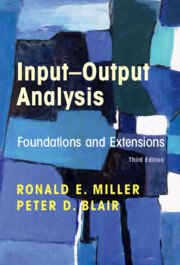Book contents
- Input–Output Analysis
- Input–Output Analysis
- Copyright page
- Contents
- Figures
- Tables
- Preface
- 1 Introduction and Overview
- 2 Foundations of Input–Output Analysis
- 3 Input–Output Models at the Regional Level
- 4 Organization of Basic Data for Input–Output Models
- 5 The Commodity-by-Industry Approach in Input–Output Models
- 6 Multipliers in the Input–Output Model
- 7 Supply-Side Models, Linkages, and Important Coefficients
- 8 Decomposition Approaches
- 9 Nonsurvey and Partial-Survey Methods:
- 10 Nonsurvey and Partial-Survey Methods:
- 11 Social Accounting Matrices
- 12 Energy Input–Output Analysis
- 13 Environmental Input–Output Analysis
- 14 Mixed and Dynamic Models
- 15 Additional Topics
- Postscript
- Book part
- Author Index
- Subject Index
- References
11 - Social Accounting Matrices
Published online by Cambridge University Press: 06 January 2022
- Input–Output Analysis
- Input–Output Analysis
- Copyright page
- Contents
- Figures
- Tables
- Preface
- 1 Introduction and Overview
- 2 Foundations of Input–Output Analysis
- 3 Input–Output Models at the Regional Level
- 4 Organization of Basic Data for Input–Output Models
- 5 The Commodity-by-Industry Approach in Input–Output Models
- 6 Multipliers in the Input–Output Model
- 7 Supply-Side Models, Linkages, and Important Coefficients
- 8 Decomposition Approaches
- 9 Nonsurvey and Partial-Survey Methods:
- 10 Nonsurvey and Partial-Survey Methods:
- 11 Social Accounting Matrices
- 12 Energy Input–Output Analysis
- 13 Environmental Input–Output Analysis
- 14 Mixed and Dynamic Models
- 15 Additional Topics
- Postscript
- Book part
- Author Index
- Subject Index
- References
Summary
Chapter 11 expands the input–output framework to a broader class of economic analysis tools known as social accounting matrices (SAM) and other so-called extended input–output models to capture activities of income distribution in the economy in a more comprehensive and integrated way, including especially employment and social welfare features of an economy. The basic concepts of SAMs are explored and derived from the SNA introduced in Chapters 4 and 5, and the relationships between SAMs and input–output accounts are presented. The concept of SAM multipliers as well as the decomposition of SAM multipliers into components with specific economic interpretations are introduced and illustrated. Finally, techniques for balancing SAM accounts for internal accounting consistency are discussed and several illustrative applications of the use of SAMs are presented.
Keywords
Information
- Type
- Chapter
- Information
- Input-Output AnalysisFoundations and Extensions, pp. 501 - 546Publisher: Cambridge University PressPrint publication year: 2022
